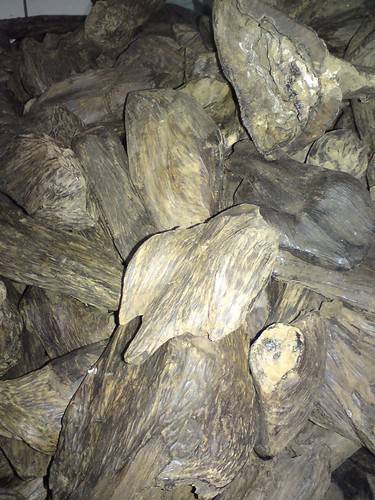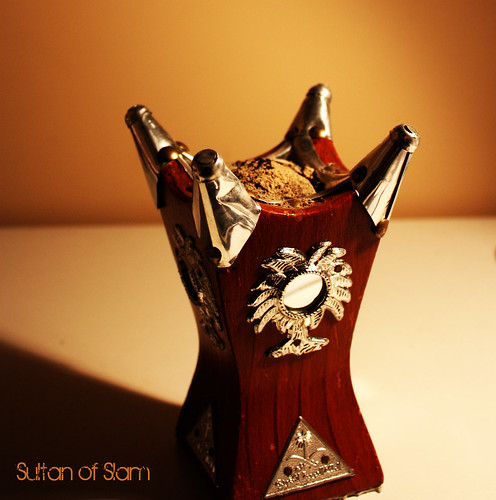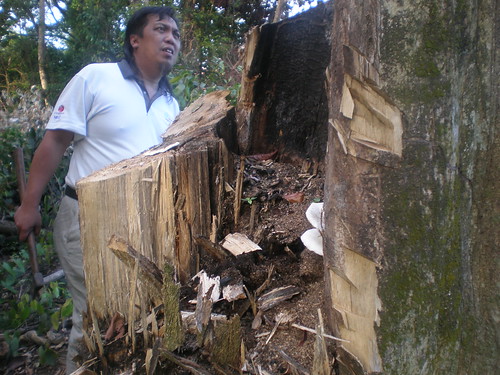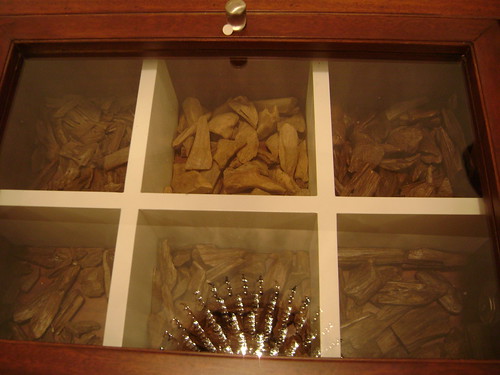
Did you know that the two most prized woodsy perfume and incense materials owe their existence to parasites?
East Indian Sandalwood (Santalum album) is, in fact, a parasitic tree which feeds on neighbouring trees through its roots system. And the most expensive natural raw aromatic in the world, agarwood, smells like nothing special until the tree is injured and becomes infected with parasitic molds and fungi, which causes it to produce a dark resin in the heartwood and inside the roots.
Formation of Agarwood
Agarwood is a resin that develops in several trees from the genus Aquilaria. Several different fungi are associated with the presence of agarwood, including Phaeoacremonium parasitica, but it remains unknown what exactly causes the formation of agarwood. It has been associated with physical injury of the tree, bacterial and fungal infection that cause production of resin, and also is reputed to be more likely found in older trees (between 20-50 years old).
The resinous (meaning infected) Aquilaria heartwood, aka agarwood, is unusual comparing to other woods, because it sinks in water. The Chinese name for it Chén-xīang means exactly that – “wood that sinks”; and the Japanese Jin-Koh means incense that sinks.
Only the resinous wood is called “agarwood” and is valued for incense and essential oil production. There are about 8 out of the 15 of the genus Aquilaria that produce agarwood. Aquilaria agallocha, aka Aquilaria malaccensis is the most highly prized in most places (also called “black agarwood” in Tibet).
The Trees
 Agarwood is formed in several indicidual species, all from the Thymelaceae family. The main one know is from the Aquilaria genus, and to a lesser extent Gyrinops, It is very difficult to tell from what species a piece of agarwood was originated from, even with sophisticated technology and expert knowledge. Most of the time, agarwood’s species of origin is recognized by its place of origin, which can indicate what species grow there that form agarwood. For a full list of agarwood forming speices click here.
Agarwood is formed in several indicidual species, all from the Thymelaceae family. The main one know is from the Aquilaria genus, and to a lesser extent Gyrinops, It is very difficult to tell from what species a piece of agarwood was originated from, even with sophisticated technology and expert knowledge. Most of the time, agarwood’s species of origin is recognized by its place of origin, which can indicate what species grow there that form agarwood. For a full list of agarwood forming speices click here.
Aquilaria malaccensis aka A. agallocha is an evergreen tree, about 15-30 meters tall with a trunk up to 1.5-2.5 meters in diameter. It is native to Southeast Asia and is widespread in that region. It grows in Bangladesh, Bhutan, India, Indonesia, Iran, Malaysia, Myanmar, Philippines, Singapore and Thailand. Aquilaria is quite an adaptable species, and grows in many different habitats and altitutdes, including sand, rocky slopes and even near swamps. They grow in areas with average daily temperature of 20-22 degrees C.
Etymology
“Spikenard and saffron, calamus and cinnamon, with all frankincense trees, myrrh and aloes, with all the chief spices.” (Canticles, 4:14).
Agarwood is also referred to in the bible as “ahalot” or “ahalim” and is mentioned in the same breath with myrrh in several books of the bible (including Canticles and Psalms).
Agar is the Hindi name for it, where as in Assam it is called ogoru. In Western literature it is called aloes, aloeswood or eaglewood; in Arabic and Muslim countries where it is most admired, it is called oud, aud, audh gaharu; in Indonesia and Malaysia; and kyara is the name for the highest grade of agar in Japanese – to name just a few of the titles it goes by.
Description of the Scent
Agarwood oils posess a woody, animalic, musty, fungus-like, slightly medicinal, warm, musky scent. Some agarwood oils resemble sandalwood and spikenard, especially ones that are lighter in colour. Darker agarwoods, such as the cultivated agarwood CO2 produced in Assam, India have a scent like no other woody oil, that can be described as intensely animalic, reminiscent of ambergris but stronger and more penetrating, with an underlining note that is sweet and raspberry-like.
As for the incense, which is how agarwood is used more than any other – it varies greatly depending on the quality and resin content. The one agarwood incense that I have experienced was a Japanese incense stick of Kyara, and it was extremely refined and transcended above any other incense experience I’ve had. It was smoldering yet delicate, and brought an immediate sense of peace and depth to my existence. I have 4 little agarwood chips from 4 different places in the world, and some very basic koh-doh incense tools, but I am still waiting for the right moment to burn them. With this feature article, the moment have arrived, and once I have burnt them I promise I will write about each of them here on SmellyBlog.
Harvesting, Sustainability and Ethical Issues
Although only infected trees are odorous and possess potential for monetary value, many uninfected trees are felled and chopped in hopes of finding agarwood within the trunk and roots. This poses a serious danger to the species of Aquilaria in general, and Aquilaraia malaccansis in particular.
Only 7-10% or wild Aquilaria trees will develop agarwood. There are varying opinions and evidence about relationship between the age of the tree, its size and the yield of agarwood it may offer. Some say that the larger the tree, the higher agarwood content it will have – and that trees should be harvested between ages 20-50 to maximize yield of agrawood. On the other hand, there is evidence that agarwood occurs in trees as young as 3 years of age.
Although there could be some relation between dying trees (indication to that are dry brown leaves, leafless branches and bumps on the trunk and brances), aquilaria trees may show little or no signs of having agarwood within them. The tree has to be felled and split open to discover the precious resinous agarwood within. Unfortunately, this led to over-harvesting of aquillaria and the trees have become an endangered species to various degrees as a result. The (misinformed) belief that agarwood develops in the tree after it is chopped down also did not help in the matter.
In the past 10 years or so, some actions are finally being taken to reduce the risk of agarwood’s extinction, including research, regulations (mostly by CITES - Convention on International Trade in Endangered Species of Wild Fauna and Flora) development of more sustainable harvesting practices, and finally – plantations of aquilaria trees for agarwood production.
By using new methods of harvesting, agarwood trees can stand and continue living: the tree is injured by making a hole in the bark, and once the agarwood is produced in the tree, it is scooped out so to speak, yet without cutting down the whole tree. Sometimes, a piece of round clay is used to keep the hole ajar so that agarwood can be collected repeatedly in the future (see above photos).

Hand repotting of 4 month old Agarwood saplings, originally uploaded by Plantation Capital.
Sustainable agarwood is also produced in agarwood plantations (especially in Assam, India), where using methods of injuring and infecting the trees with pegs carrying the agarwood inducing fungi and molds, to produce agarwood in the trees at a younger age. Similar methods are also used now in the wild, so at least this avoids unnecessary felling of trees that don’t even bear agarwood.
Forms of Agarwood Available, Grading and Pricing
Agarwood is sold in the wood in several forms, or as an essential oil. The wood can be extracted into either an essential oil or by a CO2 extraction, which is a relatively new method.
The wood is sold in powdered sawdust form, wood chips, wood pieces and to a lesser extent – as whole logs of wood.
The whole wood is mostly in demand in Japan for building private shrines. As an incense material, it has a near guarantee for no adulteration; but it will provide no consistency as some parts of the wood will be more infected than others, and some may not be infected at all. So its use for incense is not so practical for the end consumer.
The wood comes in many different sizes, forms and grades. Wood chips are more common, because they are easier to carry, transport, grade and use by shaving off small pieces for incense burning rituals. Wood chips will be graded based country of origin and their quality, which is based on both resin content and the particular demand within the country they are sold. The price for agarwood is oftern based on rarity rather than quality. So if you intend on buying agarwood, you should really know agarwood well and know what you will be using it for - rather than buy the highest price you can afford.
Another important thing to know when buying agarwood pieces for incense is that the appearance alone is not enough for deciding on the quality; neither is the smell of the wood as it is; it must be burnt as incense to fully evaluate its quality and scent.
Adulteration of the Wood
Agarwood powder is the most prone to adulteration or low quality. Agarwood powder is extremely lower in price comparing to agarwood chips and pieces of wood. This is because it is usually either by product of the agarwood oil manufacturing (i.e. the powder of the wood after it has been distilled and the true agarwood resin has been removed from it); or is simply sawdust from the uninfected Aquilaria. It is mostly used for incense production, as an odour-neutral base for incense sticks and cones.
Agarwood chips aren’t risk-free for adulteration either. According to traders from Mumbai, India “common chip adulterants were ‘lodh’ (possibly Symplocos racemosa) and ‘astrang’ (possibly Mandragora officinalum)”. (see: HEART OF THE MATTER: AGARWOOD USE AND TRADE AND CITES IMPLEMENTATION FOR AQUILARIA MALACCENSIS by Angela Barden, Noorainie Awang Anak, Teresa Mulliken and Michael Song )
Some traders will also mix resinous chips with uninfected wood to increase the weight and their profit.
Other forms of adulteration of wood include impregnating sculptures or beads carved from other woods, with agarwood oil. Aquilaria (the non infected wood) is very soft and difficult to work with, and even more so can be said for agarwood.
Adulteration of the Oil
High quality agarwood oil has a unique scent that cannot be reproduced synthetically, and any effort to do so will be very costly. As mentioned before, there is far more demand for agarwood than there is supply (thes supply is only 40% of the world-wide demand).
Agarwood essential oil is the most expensive essence in the world. Grades vary quite greatly, but it is not uncommon to find agarwood oil sold for $14,000-30,000 per kilogram! All of these factors make agarwood very attractive target for adulteration, mostly with other essential oils that have similar odour profile, i.e.: woody, musty, etc.
“Agarwood oil is adulterated with lodh oil, five or six other chemicals and/or agarwood powder that imparts
the fragrance of agarwood”.
It may also be blended with other natural oils that have some resemblance to agarwood and can extend its aroma (although in some cases the cost for using those is still rather high), including sandalwood, vetiver, spikenard, amyris (West Indian sandalwood), etc.
Next: Religious and cultural significance, medicinal uses, and use of agarwood in incense and perfumery.












